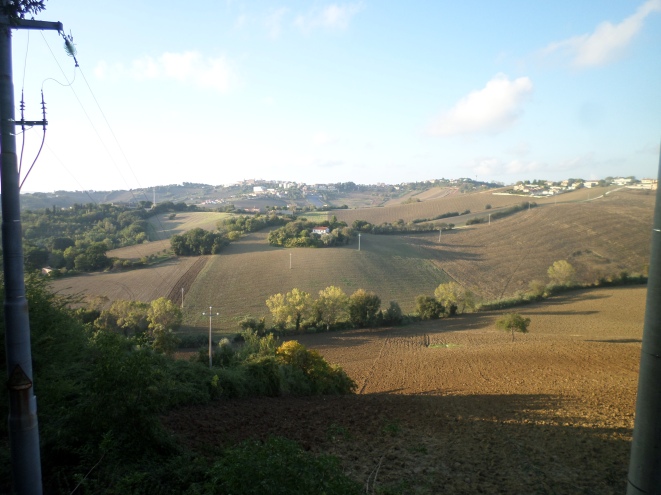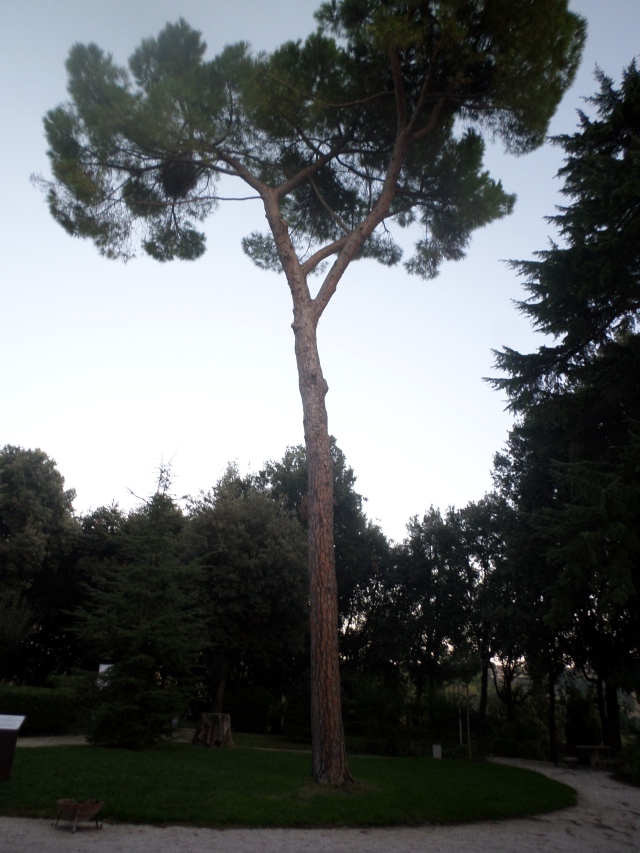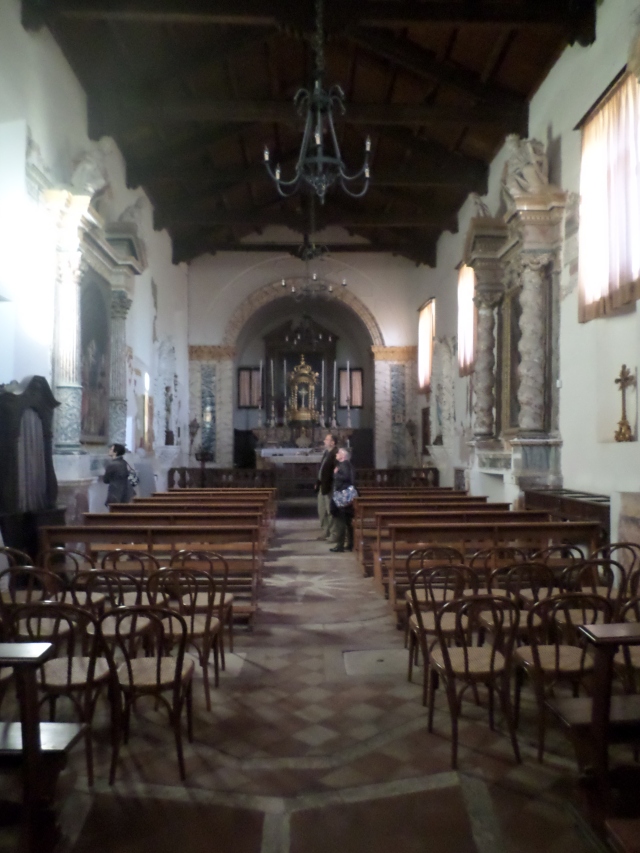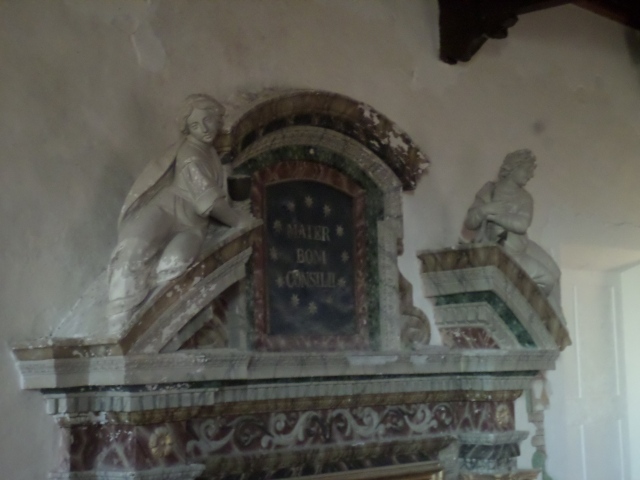It’s good to be back! It’s been a long time since my last post. Somehow Le Marche seems a long way away in the winter. Then in April I had to present two papers on my other passion, the Victorian best-seller Charlotte Yonge, at two separate meetings within a week of each other. But in May the Englishwoman’s fancy turns to thoughts of Italy, so I’ll try to catch up before we return to Corinaldo, when I’ll have a lot more to post.
We were pleased and surprised when our friend Angela offered to take us to Polverigi. It had never occurred to us to go there, not because we thought it was not worth visiting, but because it doesn’t feature in any of the standard guidebooks. Polverigi turned out to be the home of the Villa Nappi,

Villa Nappi general view, with the church tower on your left
a little gem. Obviously it’s a popular destination with locals but it doesn’t attract many foreigners.
The drive there went through landscapes typical of the best Le Marche has to offer.

On the road to Polverigi
I love that clear evening light and the swooping fields.
When we arrived we had a little stroll in the pleasant gardens before going into the Villa complex. One website describes them as “stile Liberty”, which puzzled me. How can a garden be Art Nouveau? Probably I haven’t understood the full meaning of the term “stile Liberty”.



This quintessentially Italian pine reminds me of Rome. They were a great feature of the parks of my childhood, though of course I took them for granted then. That’s partly why I love them so much; they bring back happy memories.
At the entrance of the villa was the notice below, which gives you the history of the place. Sorry about the reflected light; I think you will get the general idea anyway.

This is the courtyard of the Villa.

One wall of the Abbey’s Romanesque cloister has been retained.


Inside the cloister
I love the simplicity, harmony and sun-warmed colours of these ancient brick buildings.
With us was Angela’s cousin Carlo, founder of Arkès, a non-profit-making organisation, dedicated to the “valorizzazione” (somewhere between enhancement and appreciation) of Le Marche’s heritage. Carlo had kindly agreed to act as our guide, and added greatly to our enjoyment, particularly as I agreed with him about the sad neglect of Le Marche’s heritage. Arkès is doing its bit to remedy this.
Like so many churches in Le Marche, the church of the SS Sacramento was originally a simple and deeply spiritual Romanesque building which has been forced into the usual one-size fits-all sub-Baroque straitjacket, as you can see from the photographs below. I’m afraid the art critic Waldemar Januszczak has failed to convince me about the Baroque, even though he is a fellow Hampshire hog.

SS Sacramento exterior view of north wall with tower
Compare the simple architecture above with the elaborate interior below. Having said that, I like the columns, some of which look like recycled Roman work.

Nave of SS Sacramento looking eastwards

SS Sacramento nave looking westwards
The Chelsea Fan went up into the gallery, which you can see in the photograph, and took a photograph from there.

SS Sacramento nave viewed from the west gallery
Note the decorative floor tiles.
I particularly liked the sculptures and wall paintings.

Two angels above the Mother of Good Counsel
The figures in the photograph below fascinate me. Are they heavenly beings in armour? The one on your right looks curiously baby-faced. I don’t think it’s a cherub. Perhaps it’s meant to be a female saint, or perhaps the sculptor had, to put it politely, adopted an …er … somewhat primitive style. Or if this is a well-known trope of sacred sculpture, please tell me.

Who are these figures on the south wall?
Here are several photos of the delightful, but fragmentary, wall-paintings.

Wall painting with fantastic creatures
I think these are sea-creatures and in their cheerful vigour they remind me of the illustrations to the children’s story “Tiddler” written by Julia Donaldson and illustrated by Axel Scheffler, the Gruffalo team. Part of what I love about sacred art, and I’m not alone, is the happy paganism and irreverence that often creeps through, whether it’s wood-carving, gargoyles, sculpture or illuminations.

Wall-painting detail of plant

Wall-painting detail
The circle and stripes above seem to be part of a trompe-l’œil decorative effect to look like marble.

Another trompe-l’œil detail
I couldn’t tell what this actually represents – it’s too faded.

Wall painting detail of leaves

Wall-painting – two jugs
These may be the jugs used for the wine and water for Holy Communion, which have been painted into the niche to create another trompe-l’oeil effect.
There is a sweet little formal, or Italian-style, garden attached to the church.

Italian garden beside the church
The long shadows are typical of an Italian autumn evening. Somehow they seem to be much longer than in England . They remind me of Norman Lewis’s “The March of the Long Shadows”, a novel about post-war Sicily and its independence movement. It’s a good read.
Below is a close-up of the drinking fountain you can see at the far end of the path.

Close-up of drinking fountain

Detail of drinking fountain
The lion on your right looks a bit battered.
If, after reading this, you feel inspired to visit the Villa Nappi, this is the best web page I could find with a map.http://www.rivieradelconero.tv/attrazioni/53/villa-nappi.aspx . The actual Villa Nappi website appears not to exist any more. And if you can’t visit it, I hope I’ve added another to your Italian dreams!


What an enjoyable read. Like an autumnal stroll!
Sophy
>
LikeLiked by 1 person
Good, that’s I wanted to evoke.
LikeLike
Thank you for sharing photos from your trip. I always love to see the old churches and the views were beautiful.
LikeLiked by 1 person
Thank you. I’m glad you like old churches because I like them too and feature them quite often.
LikeLiked by 1 person
Hi Alys. To my shame I have only just got round to reading this but much enjoyed it. Lovely photos. I do agree with your comment on the way paganism and irreverence creep in – think of all those Green Men in so many old churches.
LikeLiked by 1 person
So glad you enjoyed this. Edward took the photos!
LikeLike